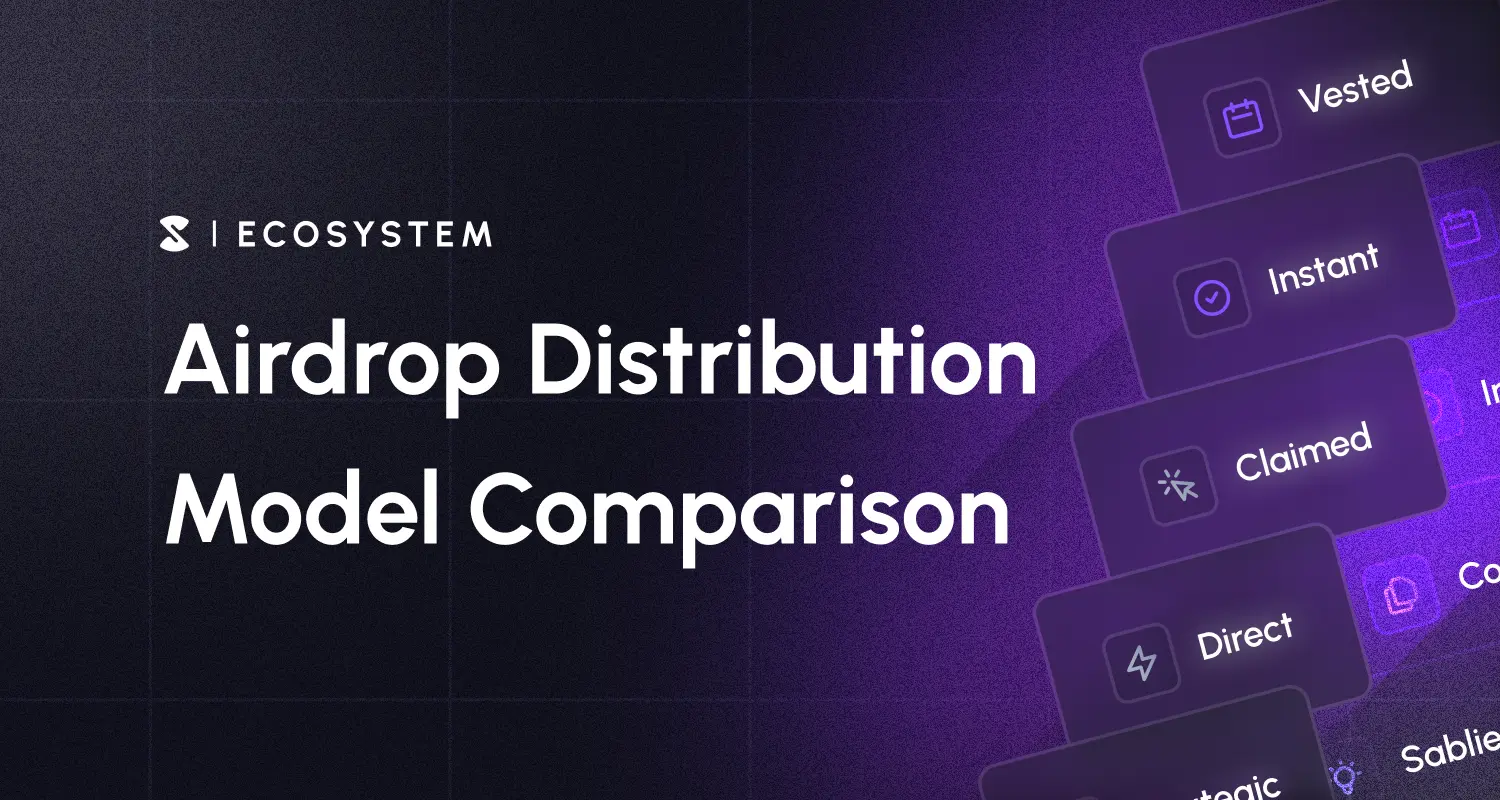Airdrop Distribution Models Comparison (2025)
The why and how of vested, manual-claim, and direct-transfer airdrops.

Airdrops have become the standard way to launch a token in the crypto industry, consistently used to attract new community members, reward early supporters, or start up a new governance program. But “airdrop” is a broad term. Behind every airdrop campaign, there are decisions about lockups, claiming mechanisms, costs, user experience, and long-term strategy. This report looks at three distinct distribution models for airdrops:
- Instant but Manually Claimed Airdrops – Tokens are distributed instantly but require user action to claim
- Instant and Directly Transferred Airdrops – Tokens are sent directly to recipients with no effort required
- Vested Airdrops – Tokens are distributed over time to recipients
Each approach shapes user behavior, community sentiment, as well as the token’s market trajectory. Whether your goal is to prevent huge sell-offs, maximize user engagement, or simply get tokens into as many hands as possible, choosing the right distribution method is critical.
In this article, we explore each distribution’s mechanics, highlight real-world examples, and analyze strategic considerations so you can decide which fits your project.
1. Vested Airdrops
How They Work
In a vested airdrop, recipients know they have a certain allocation of tokens but cannot immediately use or sell the entire amount. Instead, these tokens unlock incrementally—maybe monthly, block-by-block, or at key milestones—over a set time period. Some projects build advanced structures such as penalties for early withdrawals or reassigning forfeited tokens to loyal holders. Most vested airdrops require a manual claim transaction from the end recipient to start the token vesting.
Typically, vesting is enforced by a smart contract that either:
- Holds the full allocation in escrow and releases portions over time, or
- Deposits the tokens in the user’s wallet with transfer restrictions (a token-level “transfer lock”), though this requires specific token contract features.
Key Example:
- Exactly (EXA 2023): distributed tokens to protocol participants but vested them over time. When users claimed the airdrop, a vesting stream was created in which the tokens were gradually released.
Pros
- Reduced dumping risk: vesting prevents massive sell pressure on day one.
- Long-term alignment: the gradual release of tokens incentivizes recipients to stay active in the community.
- Behavior incentives: vesting conditions (staking, governance participation, etc.) can be enforced before full ownership.
Cons
- User frustration: some users dislike partial or delayed access; if the token’s value drops mid-vesting, they feel trapped.
- Market overhang: future unlocks loom over the market, creating the possibility of predictable sell pressure.
Who Should Use Vested Airdrops?
Projects aiming to avoid pump-and-dump speculation. Protocols that want an active, loyal holder base often prefer vesting to ensure new token recipients are genuinely aligned. For instance, Safe (SafeDAO) gave half of its airdropped governance tokens immediately but vested the other half over four years, ensuring recipients would remain involved.
Sablier is an ideal fit for vested airdrops, learn more here.
2. Instant but Manually Claimed Airdrops
How They Work
With instant but manually claimed airdrops, tokens are allocated to a set of addresses, but each recipient must visit a claim portal or interact with a contract to get their tokens. Projects often post a “Merkle root” onchain that encodes who is eligible and for how much. The user provides a Merkle proof in a transaction, the contract verifies it, and then transfers the tokens.
Key Example:
- Uniswap (UNI, 2020): famous for awarding 400 UNI to every wallet that had used Uniswap before a certain date. Instead of sending tokens to hundreds of thousands of addresses, they deployed a Merkle distributor and let users claim individually, shifting gas costs onto the claimants.
Pros
- Gas efficiency for the project: airdrop recipients pay their own transaction fees.
- User engagement: claiming can be paired with educational or governance steps. It also ensures that only those who care retrieve tokens.
- No unintended token burning: if someone never claims, those tokens stay in the treasury or revert to the project.
Cons
- Phishing risk: fake “claim sites” can fool users. Major airdrops often see scammers swarm in.
- Potential bottlenecks: if a highly anticipated airdrop goes live at once, the claim interface can crash (e.g., Arbitrum’s ARB launch).
Who Should Use Manual-Claim Airdrops?
Projects on high-fee networks like Ethereum that want a cost-effective way to distribute tokens. Also, any project that wants recipients to “opt in,” ensuring only engaged community members claim. Many top DeFi governance tokens (ENS, Optimism, Arbitrum) took this route to reduce project gas costs and filter out casual or inactive wallets.
3. Instant and Directly Transferred Airdrops
How They Work
The easiest model from the user’s perspective: tokens simply appear in their wallet. The project either scripts a batch of transfers or (in a blockchain fork) automatically credits everyone at genesis. Recipients do nothing, one day, they just see new tokens.
Key Example:
- Bonk (BONK, 2023): a meme coin that airdropped 50% of its total supply to various community segments. Because Solana’s fees are low, the team could afford direct transfers to over 100k wallets.
Pros
- Zero effort for users: a “no-click” airdrop creates goodwill since holders wake up to free tokens.
- Wider reach: ensures everyone in the intended group ends up with the token. No deadlines, no missed claims.
- Immediate circulation: perfect for quickly seeding liquidity and decentralizing supply.
Cons
- High sell pressure: everyone has access on day one, so mass dumping can occur instantly.
- Expensive for the sender: on blockchains like Ethereum, directly transferring to thousands of addresses can cost a fortune.
- Risk of spam or lost addresses: tokens may go to dormant wallets or uninterested recipients; some never notice they have it. This effectively "burns" a portion of the supply.
Who Should Use Direct Airdrops?
Well-funded projects on low-fee chains, or blockchains that want to immediately distribute tokens to a huge base of users. Hard forks also fit this model, since everyone automatically duplicates balances. While extremely user-friendly, direct distribution can cause dramatic, immediate price swings if large numbers of recipients decide to sell.
Deeper Strategic Considerations
1. Preventing Instant Dumps
- Vested airdrops are the most obvious solution: you can lock tokens in a smart contract, releasing them gradually.
- Manual claims help somewhat, since unclaimed tokens are effectively out of circulation.
- Direct transfers face the biggest risk of day-one dumping unless your community is strongly motivated to hold.
2. Community Engagement
- Vested distributions encourage ongoing participation if the contract or project rewards behaviors like staking or governance.
- Manual claims drive users to your site, letting you capture attention and guide them through any onboarding or governance steps.
- Direct airdrops minimize friction but risk minimal engagement: a user who received tokens passively might sell them without ever visiting the project’s page.
3. Technical Complexity
- Vesting demands robust, audited smart contracts. A ready-made solution like Sablier can be used instead of building a custom solution yourself.
- Manual claims can be simpler but still require a well-tested distribution or Merkle-proof system. Front-end reliability is crucial. Here again, Sablier can be used.
- Direct airdrops are conceptually straightforward. However, you might pay high gas fees, face rate limits, or cause network congestion if the drop is huge.
4. Hybrid ApproachesMany projects combine elements. For instance:
- Half immediate, half vested: Safe (SafeDAO) gave 50% of tokens right away, the rest vested over four years. This balances instant ownership with stable, locked supply.
- Partial direct, partial manual claim: some propose a small direct drop so everyone notices, plus additional tokens that must be claimed or earned.
- Activity-based vesting: projects like Osmosis used mission-based unlocking, requiring certain actions (liquidity provision, governance votes) before more tokens release.
Conclusion
Vested, manual-claim, and direct-transfer airdrops each have unique trade-offs, and there’s no universal one-size-fits-all. Many successful projects have blended strategies to fine-tune distribution and keep their community engaged. Vesting aligns recipients to the project’s success by locking up tokens over time.
Manual-claim airdrops let only the most active and interested participants claim their tokens. Direct airdrops guarantee a frictionless experience and a broad user base, but can be expensive for the project and result in immediate sell pressure.
Ultimately, airdrops are more than free tokens—they’re a first impression and a distribution of ownership. Projects should carefully consider their goals (community building, governance, anti-dump measures) and the user experience in each approach. A well-executed airdrop can jumpstart network effects and foster loyal holders.


